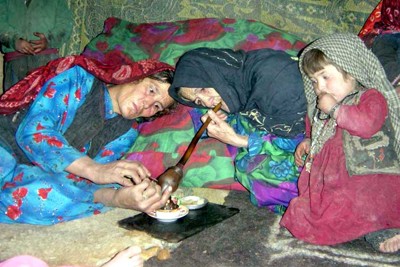By Tan Ee Lyn
KABUL- Scarred by decades of turmoil and grief, 66 percent of Afghans suffer from depression or some form of mental disorder, and an increasing number are turning to illegal drugs, a top health official said.
Afghan deputy health minister for technical affairs Faizullah Kakar said mental illness and drug abuse were the most urgent health problems that the country now needs to tackle.
"It's like a bunch of very dry wood, something very little can ignite a population that's depressed (resulting in violence). It affects many institutions, people in government, parliament," Kakar said in a wide-ranging interview with Reuters.

Ministry of Counter Narcotics and U.N. Office on Drugs and Crime, found nearly 1 million addicts in this nation of about 30 million people, including 60,000 children under age 15.
"Sixty-six percent doesn't spare those of us who work in the government, it affects progress. Depressed people don't like to work. The immediate problems are suicide ... family violence, drug addiction," he said over the weekend.
"Depressed people like to take drugs and they get more depressed, it's a vicious cycle, this is what we see in Afghanistan. Drugs have mixed up with depression and we have an expansion of the number of people who are at risk."
Afghanistan is the world's number one producer of opium, from which heroin is derived. It had an estimated 920,000 drug addicts a few years ago. "This may be greater now," Kakar said.
With only two psychiatrists working in the state sector in a country of 26 million people, it is hard to imagine how Afghanistan can cope.
"We must train doctors in the basics of mental health so they can go to villages and identify patients with mental problems and help them. This is the most urgent health issue," Kakar said.
More public education is needed as most Afghans have never even heard of anti-depressants, he said.
FIGHTING TO REACH EVERYONE
Afghanistan's health sector has made big improvements since U.S.-led and Afghan forces ousted the Taliban in the wake of the Sept. 11 attacks. Foreign funds have helped increase the number of healthcare facilities to 1,429 from just 550 in 2001.
The government has pushed for better care for pregnant women and children, two groups very vulnerable in the last three decades of violence. But there are no recent statistics to show whether figures like maternal mortality, which stood at a staggering 1,600 per 100,000 live births in 2005, have come down.
Eighty-five percent of the population has access to free primary healthcare, up from 9 percent in 2003, Kakar said.
This costs $100 million a year, or $4.50 per person - but that is still a fraction of decent standards.
"The World Health Organisation says $28 per head per year is needed, or $800 million, but we have only $100 million," he said.
The government plans to build 290 small clinics and 23 "mobile clinics" this year that will move from village to village to cover more of the population.
"These will be staffed by a doctor, nurse or a midwife," he said, adding that they will give vaccinations, prenatal care and take sputum samples to screen for tuberculosis. Those who need more sophisticated help will be advised to go to hospital.
The picture is grim in parts of the country's south and west where Kakar said government healthcare workers have not been able to provide service because of the ongoing Taliban insurgency.
"Forty of our doctors and workers died in the south, so many people are scared to go to the south to work. When we try to build a clinic in the south, it's hard to find a company that will build it. Maintaining it is a challenge."
Twenty-five percent of Afghanistan's population live in these problem areas.



